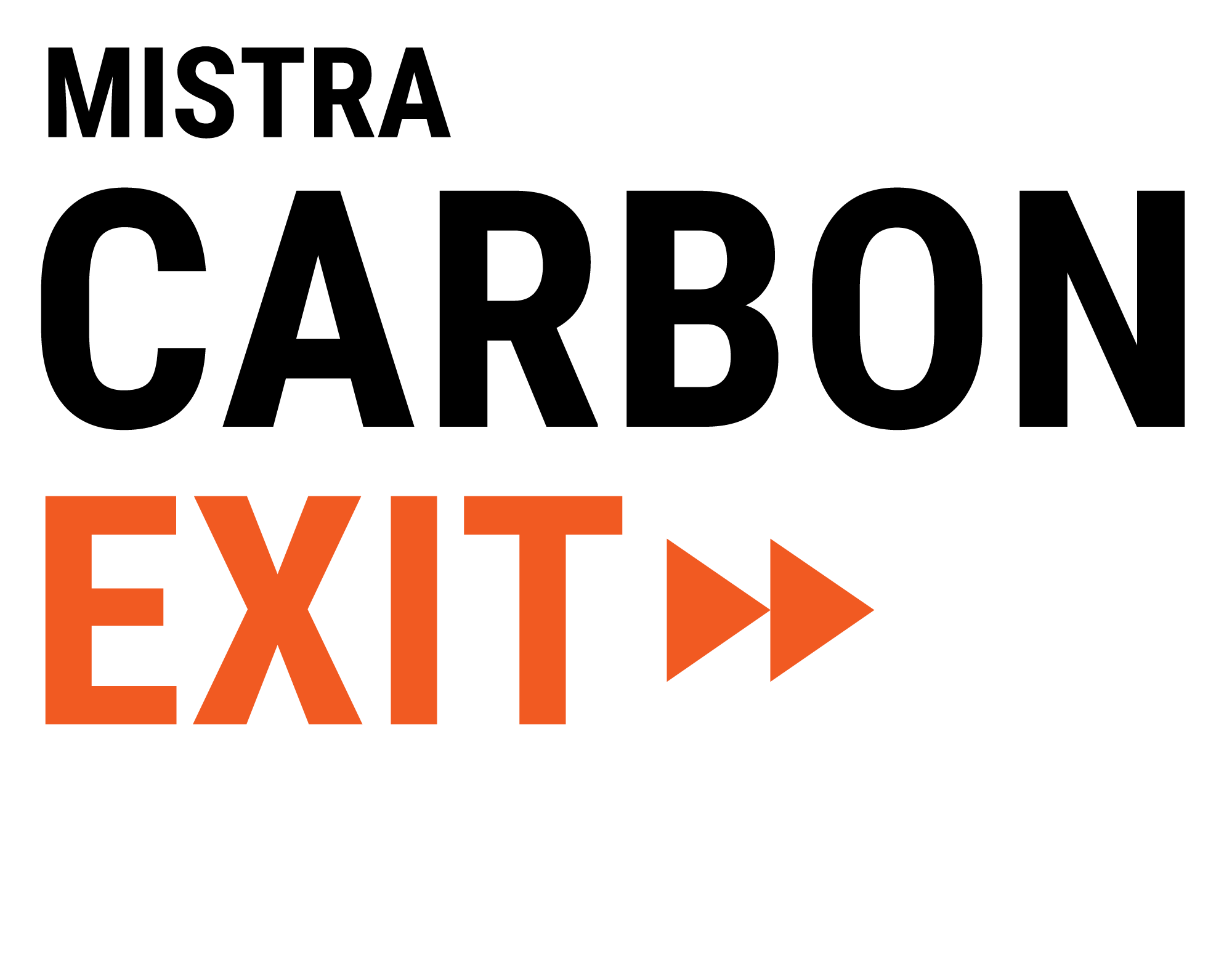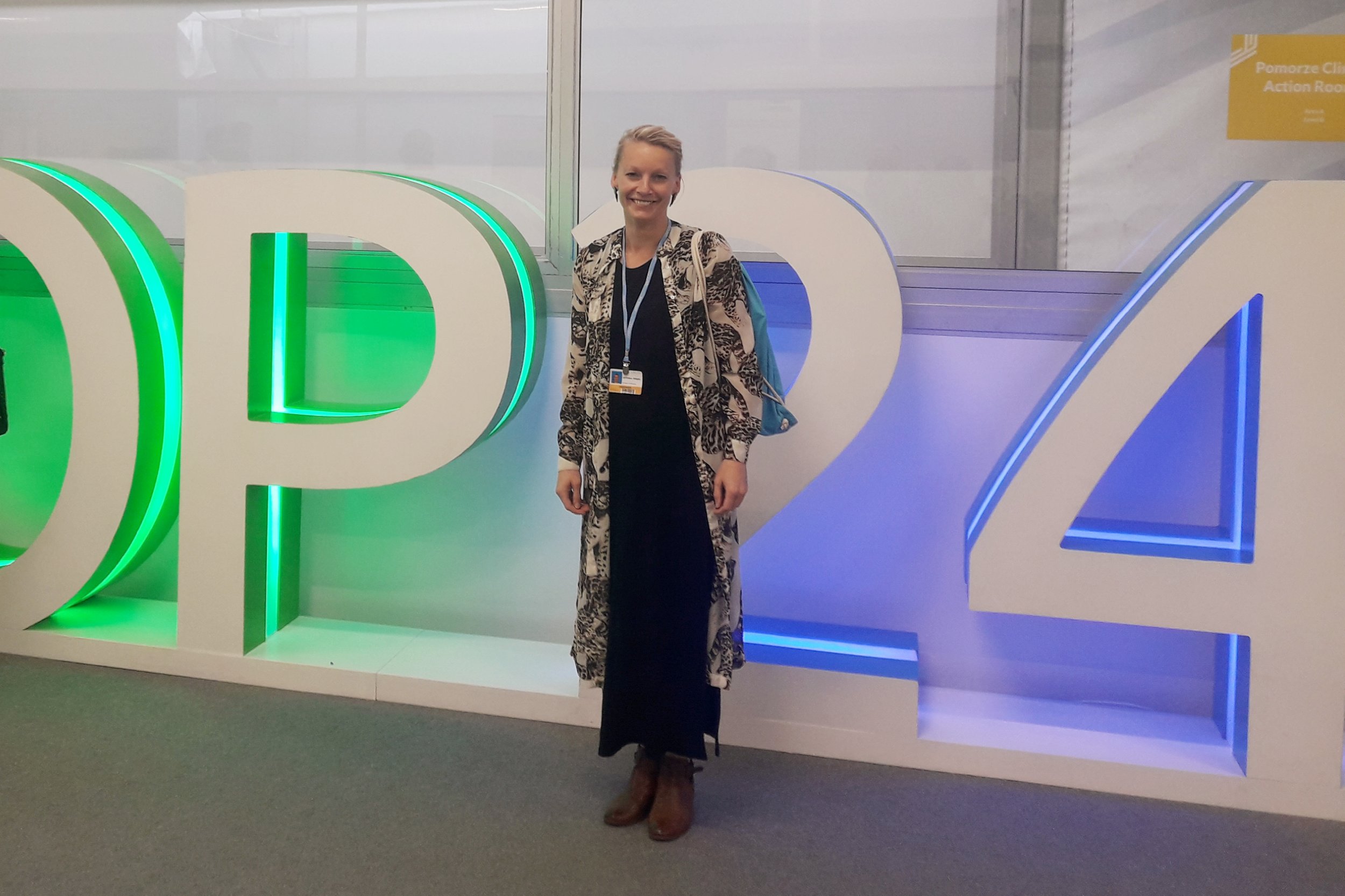Blogpost: A meeting of paradoxes - deliberations from COP24
Ida Karlsson at COP24, the UN Climate Conference in Katowice, Poland
by Ida Karlsson, Researcher in Mistra Carbon Exit
PhD Candidate Energy Technology
Chalmers University of Technology
The first week of COP24, the UN Climate Conference in Katowice, Poland was full of paradoxes. To start with, the site of the conference itself is one clear paradox. With the slogan Black to Green, Katowice has closed 18 of its 20 coal mines, one of which has been converted into the beautifully designed green roofed cultural zone housing the COP. At a first glance, Katowice appears transformed and thriving, having an unemployment rate of only 1.7% and one of Europe’s large fleet of electric buses. At the same time, the smoky haze over the city from the coal-fired residential heating is often thick and the strong ties to coal was rather unsubtle with Katowice pavilion at the conference decorated by chunks of coal stacked in metal crates parading jewelry and soaps made of coal.
“ I would say that a few clear themes have emerged from the talks: finance, the role of non-state actors, an enhanced focus on industry, partnerships and collaboration, a socially just transition, as well as moving from ambition to action.”
To continue this paradox, Poland got the first Fossil of the Day Award by NGO Climate Action Network (CAN) International on the grounds of the sponsorships of the conference and Polish President Andrzej Duda saying in his speech during the opening ceremony that there is no contradiction between climate protection and coal use, domestic coal reserves will last for 200 years. Nevertheless, the Polish presidency of the COP, led by Michał Kurtyka, has taken an active and significant role in driving the negotiations forward, chairing discussions and exploring landing grounds.
Based on my experience from the first week, I would say that a few clear themes have emerged from the talks: finance, the role of non-state actors, an enhanced focus on industry, partnerships and collaboration, a socially just transition, as well as moving from ambition to action.
Starting with finance, this is a continued sticking point in the negotiations, and while progress is seen in other areas, the talks are dragging amid wrangling over how finance flows from rich to poorer countries are counted, reported and locked in for the future. Developing countries want to know how much aid is coming; rich countries worry about ‘constitutional constraints’. But even here we see a paradox.
Already at the opening ceremony, a stream of positive developments on financing the climate transition started, with the CEO of the World Bank, Kristalina Georgieva, in a very moving speech announcing a doubling of climate funding to 200 billion dollars from 2020-2025. A landmark finance collaboration was next with the CEO of ING, Ralph Hamers, announcing that in a search for a more positive financing strategy rather than just excluding sectors and companies, ING has developed an approach to calculate CO2 emissions in entire investment portfolios with the aim to steer these portfolios towards alignment with the Paris agreement. With BNP Paribas, Standard Chartered, Sociéte Générale and BBVA joining the initiative, it will cover an astounding € 2.4 trillion in invested funds. Lisa DeMarco at DeMarco Allan LP reinforced these positive developments by noting that we have seen more movements in the last 18 months in the finance sector than we have seen over the previous 15 years with demand now outstripping supply of green projects four times over.
The role, expectations and ambition of non-state actors has been another predominant feature and we saw David Attenborough, as the "People's Voice", giving a strong reminder that the people stand behind the world's leaders and expect results from Katowice. This was followed by Arnold Schwarzenegger declaring that this is not a political issue, it is a people's issue: “The UN alone cannot do it, country governments alone cannot do it, we all have to do it together”.
Here, the UN Secretary General António Guterres remarked that countries’ nationally determined contributions (NDCs), i.e. their pledges to the Paris agreement are not sufficient, but not only that, there has been a slow-down in commitment since Paris and countries are not on track on its NDG. Even more, there has been some steps away from the Paris agreement. He continued by stating that “This could lead to pessimism, but I am not pessimistic because on the other hand other actors have stepped up: cities, private sector, sub-national governments, civil society”. Based on the recently launched Brown to Green Report, Niklas Höhne at NewClimate Institute indeed recounted that non-state actors are currently leveraging 10-15% of the emissions gap to what is required, noting that this could be scaled up towards reaching the Paris agreement.
However, Antonio Guterres later affirmed that we need national governments to take a strong part in climate action, why he announced a UN Climate Summit to be held in September 2019 in New York under the motto of A race we can win. This aims to facilitate multi-stakeholder coalitions in the areas of energy, industry, transport, cities & local change, nature-based solutions, and finance, in which national governments will need to give their view of how they are dealing with the NDCs in their economies and how they plan to raise their ambition. On this note of partnership and collaborations, I heard it mention several times in the EU pavilion, that we ought to export the “Swedish model” that we have followed with the development of the fossil-free roadmaps, and certainly this model and the Mistra Carbon Exit approach could be relevant contents for the 2019 UN Climate Summit.
The importance of cross-sectorial collaboration was highlighted so many times during this week that it would serve an entire blog note on its own, so to pick out a few nuggets, Roger Steens, Director of Sustainability at Tata Steel Europe described how they have already now started building up the hydrogen economy for when the ‘holy grail’ of hydrogen-reduced steel becomes available. They do this for example by using a share of hydrogen in the blast furnace and teaming up with a chemicals company that can use the hydrogen-rich process gas to produce chemicals such as naphtha. Roger Steen noted how a systems perspective is absolutely crucial to succeed with the low-carbon transition and reach the Paris agreement goals. This means planning carefully on a larger scale and employing each energy carrier where they can provide the most benefit from a clear energy hierarchy.
Another example came from Mahendra Singhi, the Managing Director and CEO of Dalmia (Bharat) Cement, who relayed that with an ambitious target of producing the lowest carbon cement in the world and by working to create pride in this vision in all stakeholders, whether it be employees, the community or customers, the company has managed to create the highest profits in the cement industry in India while having reduced the carbon footprint by 40% compared to competitors. In the longer-term venture to go carbon negative with support of renewable electricity, biofuel substitution and CCU, partnering is critical however and Mahendra Singhi was delighted to report promising discussions on financing from the World Bank.
I take the final example of interesting collaborative approaches from the start-up iNex Circular, one of Solar Impulse Foundations’ 1000 sustainable solutions, which has created a ‘Tinder for waste’, an advanced IT-based solution using publicly available company information, GPS data and material flows to match up companies that might have corresponding residual resources and raw material needs.
Regardless of all the showcasing of positive advances, “I am delighted by the groundswell of climate action out there”, as highlighted by Yvon Slingenberg, Director International, Mainstreaming & Policy Coordination at the European Commission; there is no doubt that the French protests which forced President Emmanuel Macron to scrap a planned fuel tax, shed its lights over the conference. Chiming in with Polish theming of the conference, ‘A just transition’, Yvon Slingenberg also noted in light of the French protests, that it is very important to be transparent and to plan ahead – policies need to be created in a dialogue, where people can see their role in the transition.
Putting some numbers into this equation, the EU long-term climate strategy just released assesses European climate action to bring an additional cost of 0.8% of GDP. On the other hand, the benefits outweigh the costs manifolds, e. g. in terms of reduced reliance on fossil fuel imports, health benefits etc. However, as portrayed by Nicola Sturgeon, First Minister of Scotland: “The transition can be frightening and feel uncertain to people, so we need to lead by example and show the economic benefits of the transitions”.
The recent on IPCC special report on the impacts of global warming of 1.5 °C, holds the just transition at its core. Hoesung Lee, the head of IPCC stated that “Alignment between moves towards a 1.5 °C climate change limitation and the Sustainable Development Goals are at the heart of creating a viable future”.
The urgency of the transition is also starkly depicted in the special report, framed very clearly by the phrase “Every bit of warming matters, every year matters, every choice matters”. Calls for going from ambition to action is strong and I believe that Urban Wästljung, Senior Advisor in Public and Sustainability Affairs at Scania put it most crisply when he stated at an event on Policy Pathways for Decarbonising Transport: “We cannot use innovation as an excuse to procrastinate - we need to act and do what we can now! Implement, implement, implement.”
On a final note from this intense week with emotions flowing both high and low, and an estimated 50 plus events and negotiation talks going on simultaneously at any one given time, I would like to end by contemplating upon the value of pausing, taking a step back, reflecting and taking a wider perspective. I shared a break with the COP24 President at the multi-sensory Vinci® Powernap installation and just like I experienced it, I could also sense his renewed vigor to tackle the difficult negotiations after this time-out. As per this memorable quote from Mahendra Singhi at Dalmia Cement: “We cannot improve the world without improving the person”.


